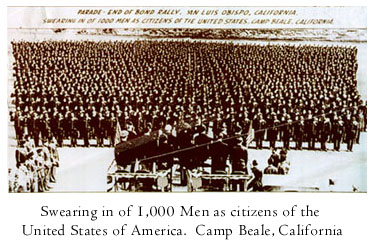Impact
of World War II on Filipino Migrant Workers
In
the 1940s and 1950s, Stockton had a sizable
Filipino community. Here an estimated 500
second generation Filipino children had emerged
more than half of whom were products of mixed
marriages. Although this pattern eventually
became the reality in many Filipino communities
in the United States, American acceptance
of the Filipinos was gradual and late.
 World
War II was significant in transforming American
attitudes toward Filipinos. At the outbreak
of the war, Filipinos were barred from joining
the armed forces. But in 1942, President Franklin
D. Roosevelt finally allowed Filipinos to
be drafted into military service. Many Filipinos
fought side by side with the Americans in
Europe and Asia. Others contributed by becoming
civilians involved in the mobilization efforts
during the war. At the end of the war, the
Filipinos had earned the acceptance and admiration
of the American public. The Filipinos regained
their dignity after many years of discrimination
and racism. Through the war, the Filipinos
had proven their right to become citizens
of the United States. An amendment to the
Nationality Act of 1940 allowed the noncitizens
who joined the military to avail of citizenship.
Close to ten thousand Filipinos availed themselves
of this opportunity.
World
War II was significant in transforming American
attitudes toward Filipinos. At the outbreak
of the war, Filipinos were barred from joining
the armed forces. But in 1942, President Franklin
D. Roosevelt finally allowed Filipinos to
be drafted into military service. Many Filipinos
fought side by side with the Americans in
Europe and Asia. Others contributed by becoming
civilians involved in the mobilization efforts
during the war. At the end of the war, the
Filipinos had earned the acceptance and admiration
of the American public. The Filipinos regained
their dignity after many years of discrimination
and racism. Through the war, the Filipinos
had proven their right to become citizens
of the United States. An amendment to the
Nationality Act of 1940 allowed the noncitizens
who joined the military to avail of citizenship.
Close to ten thousand Filipinos availed themselves
of this opportunity.
